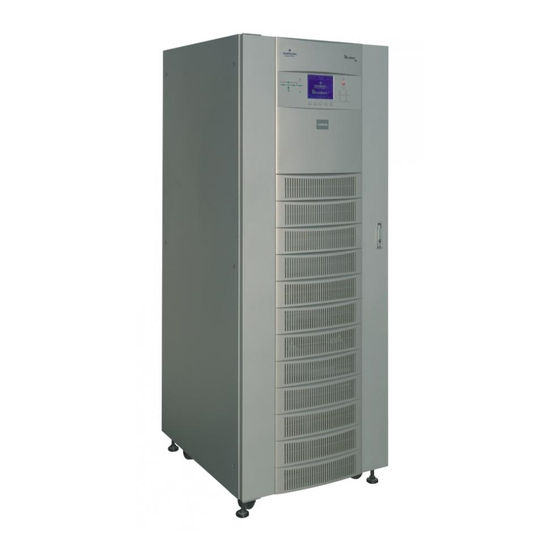
Summarization of Contents
Installing the UPS Module
Brief Introduction to Installation
Overview of factors to consider when selecting location and connecting UPS.
Unpacking and Initial Checks
Procedures for unpacking the UPS and performing initial inspections.
Location Selection Guidelines
Criteria for choosing an appropriate site for UPS and battery installation.
UPS Positioning and Clearance
Instructions for positioning the UPS unit and ensuring adequate space.
Final Positioning and Cable Entry
Securing the UPS and identifying cable entry points.
External Protective Devices
Requirements for external circuit breakers at rectifier, bypass, and output.
Power Cable Specifications
Guidelines for selecting and connecting power cables, including current ratings.
Cable Connection Procedures
Detailed steps for connecting the UPS power cables.
Control Cables and Communication Ports
Overview of control interfaces, dry contact ports, and communication options.
Input Dry Contact Port Details
Description of input dry contact terminals for external signals.
BCB and Switch State Ports
Information on BCB port and maintenance/output switch state ports.
Output Dry Contact and EPO Ports
Details on output dry contacts for backfeed protection and remote EPO input.
Communication Ports Overview
Description of RS485, RS232, and IntelliSlot communication ports.
IntelliSlot Communication Options
Details on specific IntelliSlot cards like Web, Modbus, and Relay cards.
Battery Management and Safety
Battery System Introduction
Basic introduction to the UPS battery string and backup capacity.
Critical Battery Safety Precautions
Essential safety instructions for handling UPS batteries and preventing hazards.
External Battery Power Cable Installation
Guidelines for installing and connecting external battery power cables.
Battery Maintenance Procedures
Routine checks and upkeep required for maintaining battery health.
Battery Recycling and Disposal
Instructions for the environmentally sound disposal of disused batteries.
External Battery Cubicle Connections
Recommendations for currents and cable selection for external battery cubicles.
Installing Parallel UPS Systems
Parallel System Installation Overview
General principles for installing parallel UPS systems.
1 + N Parallel System Installation
Specific steps for installing 1+N parallel UPS configurations.
Dual Bus System Installation
Specific steps for installing Dual Bus UPS configurations.
UPS Operation and Modes
UPS Operation Overview
General introduction to the UPS's operating principles.
Operating Theory and Static Transfer Switch
Explanation of how the UPS converts power and the function of the STS.
1 + N Parallel System Operation
Operational aspects and requirements for 1+N parallel UPS setups.
UPS Operating Modes
Description of Normal, Battery, Bypass, and Maintenance modes.
Battery Management Setup
Configuration of normal and advanced battery management functions.
Battery Protection Configuration
Setting up battery low pre-warning, EOD protection, and disconnect alarms.
Operator Control and Display Panel
Control Panel Introduction and Indicators
Overview of the panel, its sections, and status indicators.
Audible Alarms and Control Keys
Description of alarm sounds and the functions of control keys.
LCD Screen Types and Navigation
Explanation of Start, Primary, and Default LCD screen layouts.
Menu Items and Prompt Windows
Detailed description of menu options and system prompts.
Status and Alarm List
A comprehensive list of all possible UPS status and alarm messages.
UPS Operating Procedures
Power Switches Location
Identification and location of the UPS power switches behind the front door.
UPS Startup Procedures
Step-by-step instructions for starting the UPS in normal mode.
Startup Without Input Supply
Procedure for starting the UPS when mains power is not available.
Transfer Between Operating Modes
Methods for switching between Normal, Battery, and Bypass modes.
Maintenance Mode Procedures
Steps for entering and exiting maintenance mode.
Powering Down and Isolation Procedures
Instructions for shutting down the UPS and isolating units in parallel systems.
Insertion and EPO Procedures
Reintegrating UPS into parallel systems and activating EPO.
Automatic Restart and Reset Procedure
UPS behavior during automatic restart and reset steps after faults.
Display and Control Settings
Changing display language, date/time, and control password.
Service and Maintenance
Module Service Procedures
General notes and specific steps for servicing power and bypass modules.
Air Filter Replacement
Instructions for replacing the air filters on the UPS.
Product Specifications
Conformity and Standards
List of European and international standards the UPS conforms to.
Environmental Characteristics
Specifications for operating temperature, humidity, noise, and pollution.
Mechanical Characteristics
Physical specifications including dimensions, weight, and protection degree.
Electrical Characteristics (Input/DC/Output/Bypass)
Detailed electrical specifications for various UPS circuits.
Efficiency, Heat Losses, and Air Exchange
Data regarding UPS efficiency, heat output, and cooling requirements.
Transformer Versions
Input Transformer Version
Description of the UPS configuration with an input insulating transformer.
Output Transformer Version
Description of the UPS configuration with an output insulating transformer.










Need help?
Do you have a question about the NX 60kVA and is the answer not in the manual?
Questions and answers